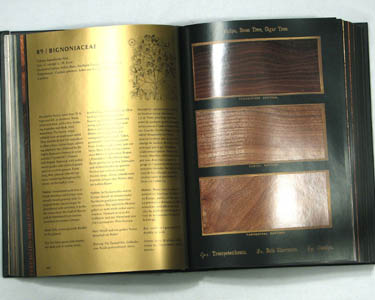HOBBITHOUSE REVIEWS OF BOOKS ON WOOD AND WOODWORKING




TITLE: The Woodbook
AUTHOR(s): Romeyn Beck Hough (this edition recompiled by Klaus Ulrich Leistikow)
PUBLISHER / YEAR: / # PAGES Taschen, 2002, 864pp
ISBN: ISBN-10: 3822817422 ISBN-13: 9783822817421 ePID: 30208889
PRICE: list $80, street price $60 to $500+ with many used ones going for about $250 (apparently it's now out of print and now selling for very high prices although a couple of places continue to list it for under $80)
There is a 2007 edition that can be had much cheaper ($20 to $50) but I don't know anything about it. It was part of a 25th anniversary set of books by the publisher.
I saw one ad for the original 14-volume edition (which has real wood, not pictures) for $16,500.
SUMMARY DESCRIPTION: A magnificent book, with full-page sets of 3 differnt views of each of 354 species of domestic (to the USA) woods. The images are just outstanding, although many of them are too orange, but the text is a disappointment for woodworkers (better perhaps for botanists since most of it is about the trees, not the wood). An expensive book, but worth the price. It was originally published in 14 volumes (between the years 1888 to 1913) with real wood slices, not pictures, and was then compiled into a single volume with pictures in 1928. This edition is a rework (not a reprint) of the 1928 version.
All of the introductory section and about half of the rest of the pages are the gold on black printing that is readable in a bright light, or at the right angle, but otherwise is nearly unreadable. It looks very elegant, but in practical terms, it is a VERY bad idea. If you buy it new, you'll get it in a thin-wood box, which I found to be overly cutesy and utterly impractical, but that's just a publisher's gimmick and you can toss it and forget about it, or perhaps, unlike me, you'll want to keep it.
Despite that incredibly annoying use of dark gold lettering on black pages this reprint of the famous 1928 work, with all new color plates, is simply phenomenal. It has the standard 3 views (transverse / cross section, radial / quartersawn, and tangential / flat cut) of each of many hundreds of native american woods. The photography is outstanding and the selection of specific wood samples is VERY well done to produce nicely representative pieces of each species. The photographs are taken from neither too far away nor too close to the wood so that the results are very useful for wood identification. These are easily the best images I have found in any book on wood, although you DO have to discount the fact that many of the images are too orange.
There is a long introductory section that describes the long process under which the original edition of this book was published in 14 volumes and then there are the 354 wood species with one page of text (in 3 languages) and one page of 3 images for each of the species. Interspersed throughout the book are occasional facing page-pairs which are entirely taken up by an enlargement of one of the images. One such pages is shown here.
In the text with each species, botanical names are given along with several common names and a very brief discussion of each wood is given in English, German, and French. More than half of the description is of the tree, not the lumber, and personally I would have much preferred that the text be entirely, or almost entirely, about the lumber, not the tree. Because the text is limited to one page per species, and it is printed in 3 languages, it ends up being just a couple of sentences about the wood; a very light treatment. The images are not little thumbnail images, but useful sizes, taking up 1/3rd of a page, thus using a full page per species just for the images. There is an index that allows you to look up a wood by botanical or common name.
This is one of the most (if not THE most) expensive wood reference works currently in print but it is well worth the price for woodworkers with an interest in detailed images of domestic woods. It does not have pictures of trees, just the lumber itself. Some of the species presented are either no longer available or have very limited availabilty.
North Carolina State University maintains an extensive web site on woods and buried somewhere in it is a full set of the ORIGINAL images from the 1928 version of this book, so you CAN get a similar set of images on-line instead of buying the book, but I still recommend the book. There are 354 domestic species represented (no exotics). The images on the NCU site are all different than the ones in this reprint. I assume that the negatives from the 1928 edition were lost or degraded and that what they have is from page scans of that edition. Their site presents each 3-wood image in 3 different sizes, which can be very convenient.
Presented to the left of this text are images of the cover, one each of the gold-background and the black-background pages, and one of the occasional pages that show an enlargement of one of the woods. Except for the cover image, you can click on the images and see a pretty much full-size enlargement. Keep in mind that these images were taken in a bright light, so the gold on black pages are readable here in a way that they are not in a more normal light.
Overall grade, A- (the pictures are A+ even with the frequent too-orange color but the text is a C)



